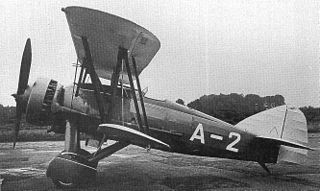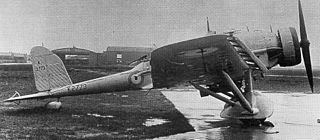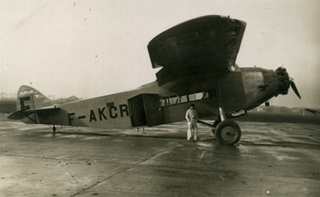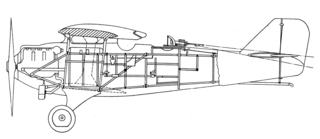
The Gregor FDB-1 was a Canadian biplane fighter, designed in 1938 by Michael Gregor and manufactured by Canadian Car and Foundry. Despite having some advanced design features such as flush rivetted all-metal construction and a retractable undercarriage, the final generation of biplane fighters was being supplanted by monoplanes and the Gregor FDB-1 was obsolete before it flew. Despite the Royal Canadian Air Force's desperation for modern fighters, the sole example remained unsold and was eventually lost in a fire in 1945. The Gregor FDB-1's model designation stood for Fighter Dive Bomber indicating its intended roles.

The Armstrong Whitworth A.W.16 was a single-engine biplane fighter aircraft designed and built by the British aircraft manufacturer Armstrong Whitworth Aircraft.

The Handley Page H.P.47 was a British single-engined low-wing monoplane built to an Air Ministry specification for a general-purpose bomber and torpedo bomber aircraft. Only one was built.

The Villiers II was a twin-seat navalised fighter aircraft designed and produced by the French aircraft manufacturer Ateliers d'Aviation François Villiers.

The Skyeton K-10 Swift is a two-seat, single-engine light sports or ultralight aircraft designed in Ukraine.
The Hanriot HD.6 was a French two-seat fighter aircraft prototype, built towards the end of World War I though not flown until after the armistice with Germany. A biplane with an unusually narrow gap between upper and lower wings, powered by a single water-cooled radial engine, it did not enter production.

The Timm T-840 was a twin engine, high wing passenger aircraft designed and flown in the United States in 1938. Equipped with a tricycle undercarriage and low speed aerodynamic devices, it could be configured to carry between six and ten passengers. Only one was built.

The Ciani EC 38/56 Urendo, or SSVV EC 38/56 Urendo is an Italian tandem-seat training glider from the 1950s. Four were built, one winning the Italian National Championships in 1959. Another, restored, still flies.
The Aviator Shershen' is a Russian two seat biplane, sold in kit form. It first flew in 2005 and several variants have been produced, with a choice of engines.
The IFIL-Reghin RG-4 Pionier or CIL Reghin RG-4 Pionier was a Romanian single seat primary glider built in the 1950s. Fifty were produced.

The Les Mureaux 3 C.2 and Les Mureaux 4 C.2 were French two seat, parasol winged fighters, flown in 1927-8, which differed only in their engines. They were developed into near identical army co-operation types, the ANF Les Mureaux 130 A.2 and ANF Les Mureaux 131 A.2, in 1929–31.
The Villiers 26 was a French naval seaplane which used Handley Page slats to provide the wide speed range required for escort and patrol duties. It was tested, behaved satisfactorily but received no production order.
The Villiers V, Villiers 5 or Villiers 5CN2 was a French night fighter built in the mid-1920s. It did not go into production.

The Villiers IV or Villiers 4 was a French two seat naval floatplane. Two were built, the first with twin floats and the second with one. The first was short-lived but the second set several world and national records; it later became the Villiers XI.
The Villiers VIII or 8amC1 was a French shipboard fighter capable of alighting on water. After competitive tests, it did not receive a production order.

The Villiers 31 or Villiers 310 was a French eight passenger airliner of advanced construction. Owing to Villiers' financial failure, it was not developed.

The Bréguet 25 or XXV was a French two seat fighter from 1925. It was heavily armed, carrying seven machine guns.

The Raab-Katzenstein RK.25 was a two-seat, low wing cantilever monoplane aircraft designed and built in Germany in the 1920s for fast touring. Three were built and one had some success in a 1928 international contest. Another was later re-engined and provided with cabin accommodation.

The G.A.C. 102 Aristocrat or General 102 Aristocrat is a single-engined cabin monoplane built in the US just before the Great Depression. It proved popular, with over forty built; an early example was taken on an aerial survey of Antarctica. One survives.
The Weber-Landholf-Münch WLM-1 is a 1940s Swiss high performance sailplane designed to meet a Swiss Air Force (SAF) requirement for a training glider that could initiate potential fighter pilots. To this end it is fast, aerobatic and equipped with standard military instrumentation. Only three were built.














